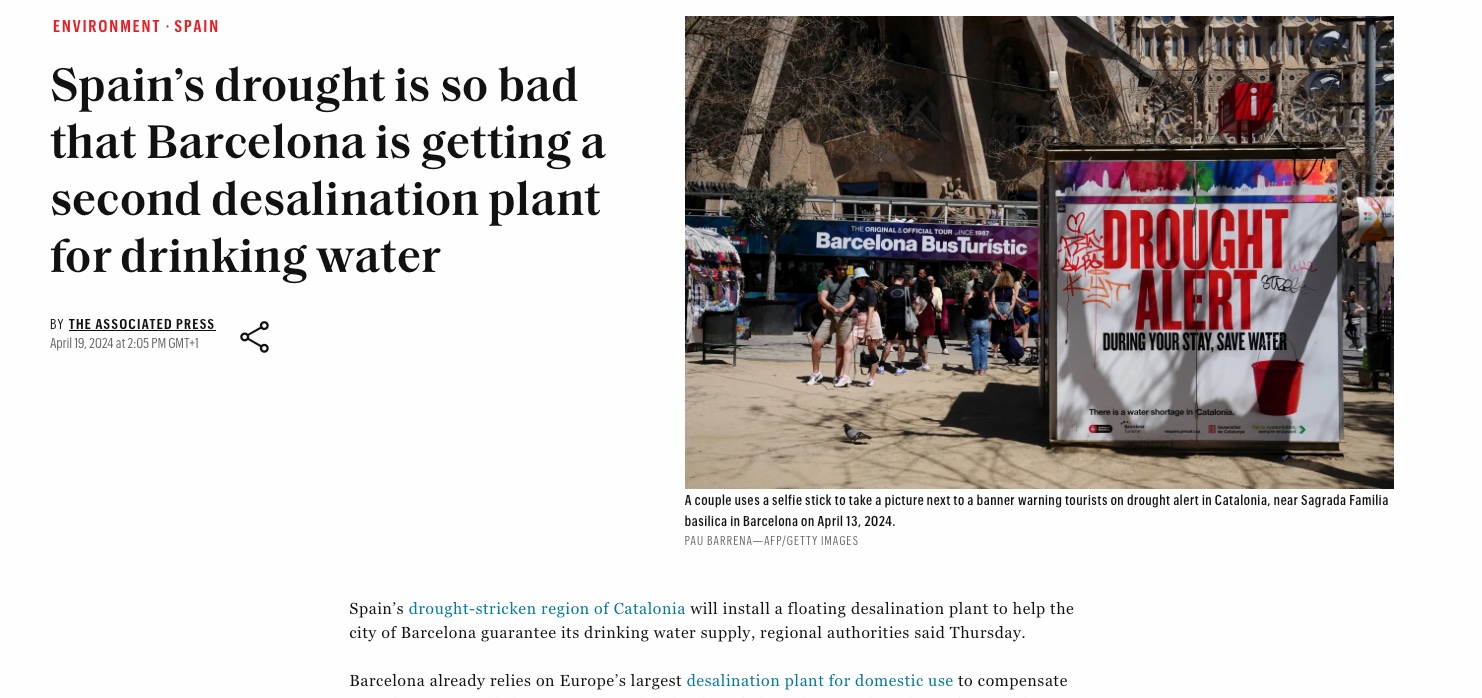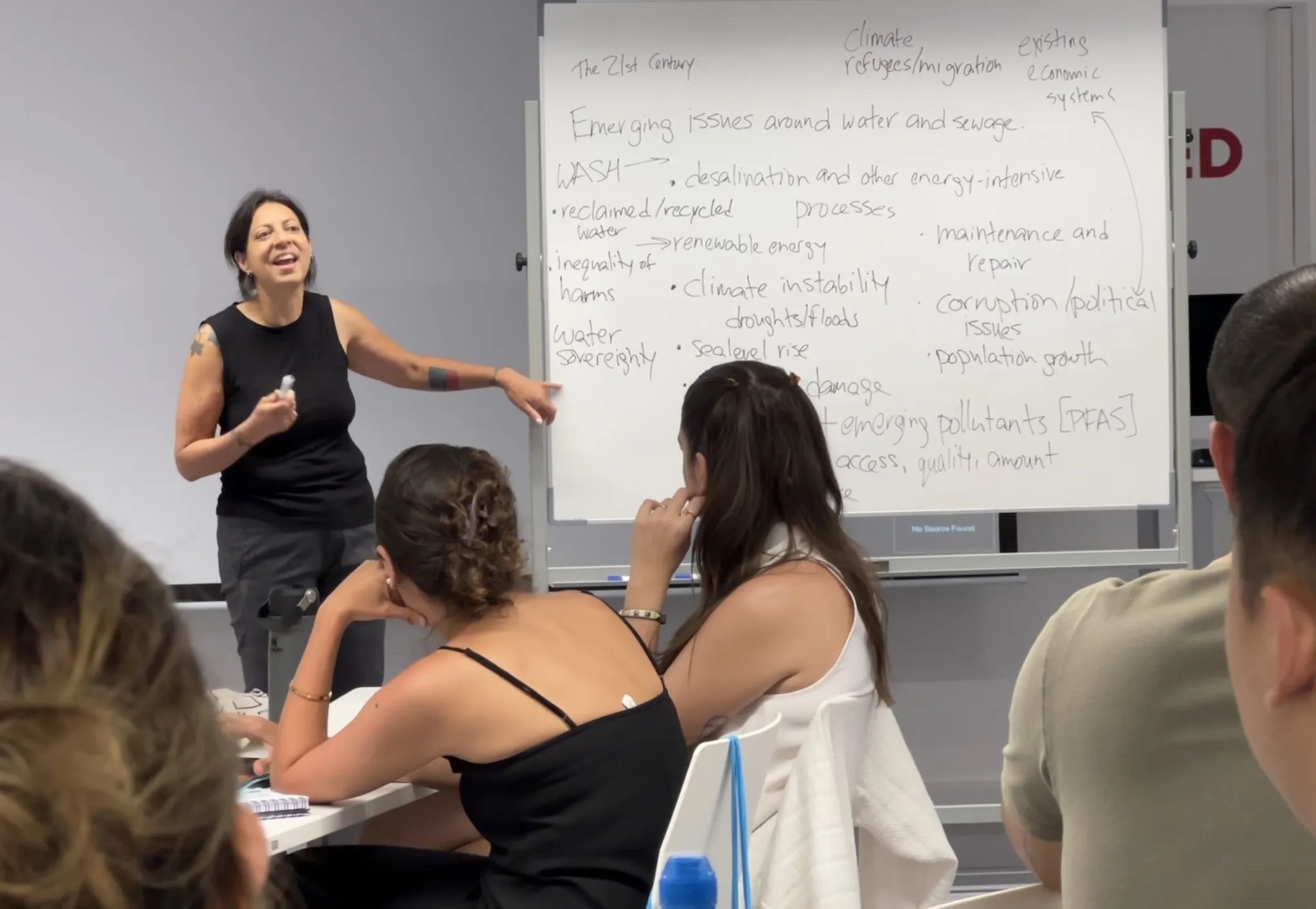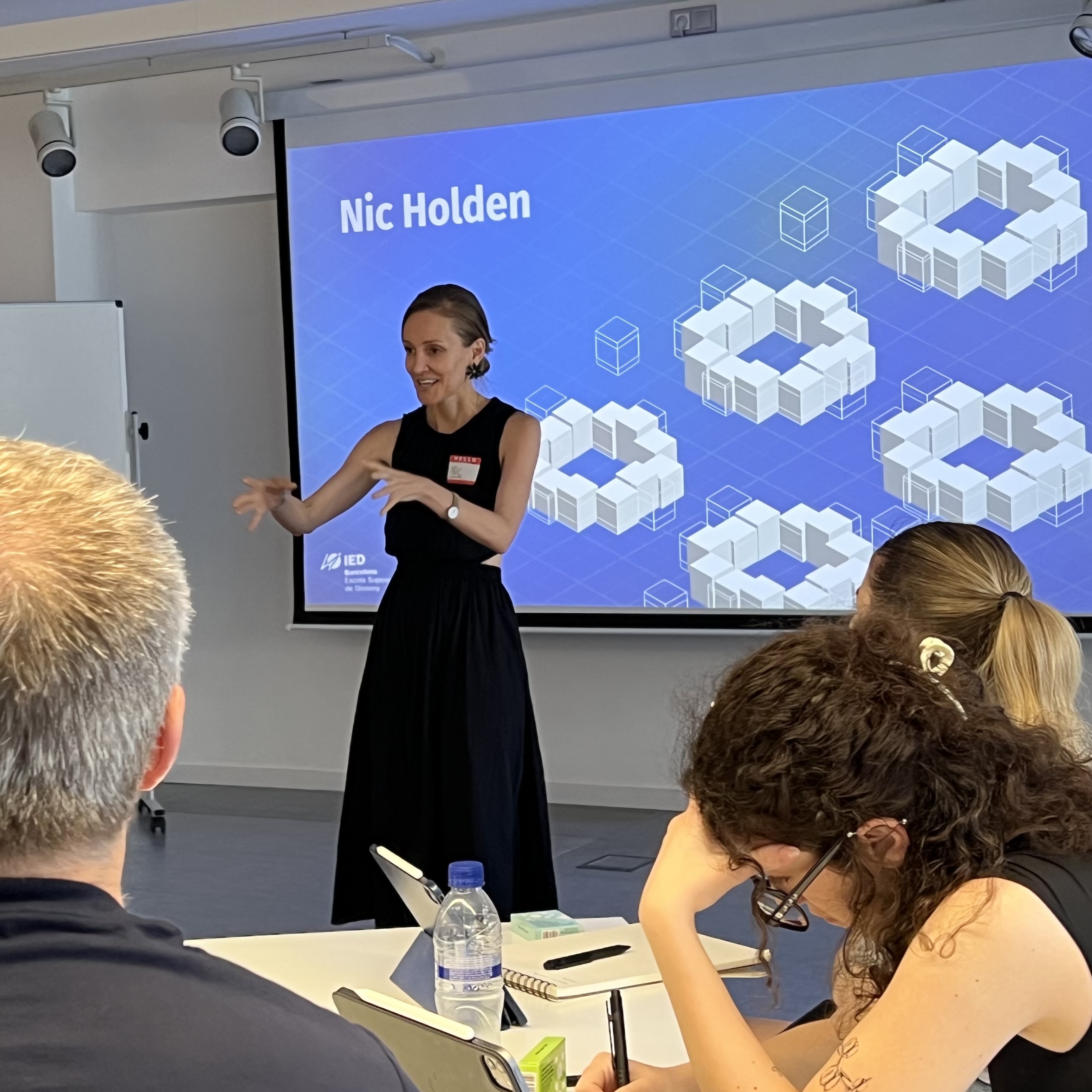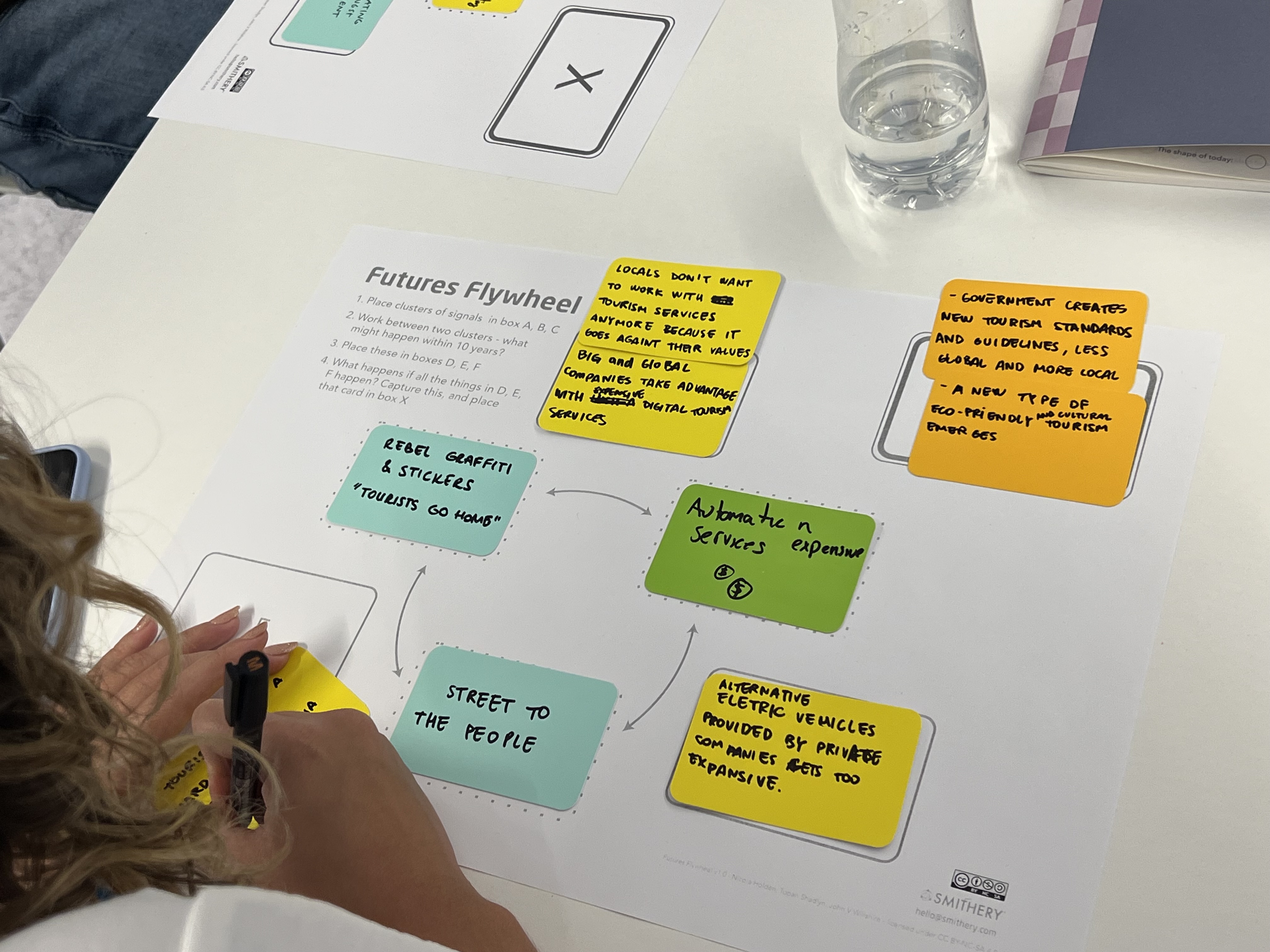Taking Care of Water
Academic Program

A green pedal boat is tied to a dock in a dried part of the Sau reservoir, about 100 km (62 miles) north of Barcelona, Spain, Tuesday, April 18, 2023. (AP Photo/Emilio Morenatti)
2023-2024
Istituto Europeo di Design Barcelona
Co-director & Faculty
︎︎︎IED Barcelona
︎︎︎Smithery
︎︎︎About the program
Istituto Europeo di Design Barcelona
Co-director & Faculty
︎︎︎IED Barcelona
︎︎︎Smithery
︎︎︎About the program
The Innovation and Future Thinking is a course is offered at IED Barcelona each summer. The program is co-directed between me and my collaborator John V. Willshire (The Smithery).
![]()

Course Context
We all use water every single day, but how often do we really stop to think about where it comes from, where it goes, and the systems which surround its meandering paths through cities and countries? The potential for emergence from such a complex area proved more inspirational than we could have imagined.
Of course our aim in the curriculum is not to develop students as experts in the given theme – although they do build a level of literacy quite quickly as a byproduct – but rather use the theme as a lens through which to explore the world and ground application. It should be a platform to help understand the methods and tools used to critically assess possible futures, and become a temporary vernacular in which the cohort can communicate their discoveries.
We shaped a course which could offer both the structure, tools, and thinking models the students could leave with and apply to other areas, whilst finding common ground that enables collaboration amongst an international group of students during a brief two weeks.
Of course our aim in the curriculum is not to develop students as experts in the given theme – although they do build a level of literacy quite quickly as a byproduct – but rather use the theme as a lens through which to explore the world and ground application. It should be a platform to help understand the methods and tools used to critically assess possible futures, and become a temporary vernacular in which the cohort can communicate their discoveries.
We shaped a course which could offer both the structure, tools, and thinking models the students could leave with and apply to other areas, whilst finding common ground that enables collaboration amongst an international group of students during a brief two weeks.
Studio Brief
If 2023 was dire for the water situation across Spain, 2024 is even worse. Officially declared a state of emergency in February, the region and city is experiencing a frenzy of activity in response, developing strategies to replenish, reuse, and reduce water.
![]()
Associated Press. Fortune article, 17th April 2024. Photo: A couple uses a selfie stick to take a picture next to a banner warning tourists on drought alert in Catalonia, near Sagrada Familia basilica in Barcelona on April 13, 2024.
The Sau Reservoir was pictured by NASA’s Earth Observatory in early March having dropped to 1% of its capacity. And though late spring rains have once again started to ease water restrictions for residents, Catalonia’s Reservoirs are only 25% full.
![]()
The Sau Reservoir, which supplies water to Barcelona sitting at less than 16% full. Source: The Independent, March 2023.
No wonder then that a wide variety of organisations around the city are mobilising to find more solutions to this systemic problem.
BIT Habitat, the urban innovation agency of the Barcelona City Council, recently announced The Proactive City 2024, an innovation call for projects aimed at responding to the urban emergency of drought and improving the integral water cycle. The theme of Barcelona Design Week this October will be What If… Water, looking at how design can contribute to accelerating the implementation of the Sustainable Development Goals (SDGs). In times of crisis, everyone looks at how they can help within their capacity and capabilities.
And we are no different. Instead of moving on to a new theme, we will be using Water as our central focus again. We are taking what we’ve learned from last year and sharpening the ambitions for this summers’ cohort to create a productive learning experience for the students of course.

Associated Press. Fortune article, 17th April 2024. Photo: A couple uses a selfie stick to take a picture next to a banner warning tourists on drought alert in Catalonia, near Sagrada Familia basilica in Barcelona on April 13, 2024.
The Sau Reservoir was pictured by NASA’s Earth Observatory in early March having dropped to 1% of its capacity. And though late spring rains have once again started to ease water restrictions for residents, Catalonia’s Reservoirs are only 25% full.

The Sau Reservoir, which supplies water to Barcelona sitting at less than 16% full. Source: The Independent, March 2023.
No wonder then that a wide variety of organisations around the city are mobilising to find more solutions to this systemic problem.
BIT Habitat, the urban innovation agency of the Barcelona City Council, recently announced The Proactive City 2024, an innovation call for projects aimed at responding to the urban emergency of drought and improving the integral water cycle. The theme of Barcelona Design Week this October will be What If… Water, looking at how design can contribute to accelerating the implementation of the Sustainable Development Goals (SDGs). In times of crisis, everyone looks at how they can help within their capacity and capabilities.
And we are no different. Instead of moving on to a new theme, we will be using Water as our central focus again. We are taking what we’ve learned from last year and sharpening the ambitions for this summers’ cohort to create a productive learning experience for the students of course.
Week One
In a two-week program the learning can feel like a sprint. The challenge is finding the balance between building foundational knowledge of futures methodologies and providing time and space for students to apply this in innovative, experimental practice.
During the first week, we introduced students to the key building blocks, while simultaneously engaging in a deeper sectoral understanding of water.
Scott Smith of Changeist joined us to kick off the week, guiding students through the landscape of where Futures methods and approaches differ, how they are used, by whom, and for what purpose.
![]() Changeist 2023
Changeist 2023
The students immediately put into practice the learnings, heading out into the streets of Barcelona to begin collecting signals related to water.
![]()
Obliquiscope by Artefact, a tool for picking signals out of the world around you
Over the course of the first week, students brought in local signals they captured while walking around the city, catering evidence with photographs, and noting individual signals on Artefact Cards.
Barcelona as a city is a vital part of our learning context, an extension of the classroom. One of the challenges of doing on-the-ground signal capture well (in addition to the constraints of time) is familiarizing oneself in a new context.
Most of the students are international, coming from Brazil, Lebanon, Mexico, Turkey, Australia, Colombia, China, and the US, to attend the course in person. And for many this was their first time in Barcelona. There is a layer of culture shock and language barrier that can make it hard to do signal scanning. It can also be an advantage to have this fresh outsider perspective; people bring their own experiences, interpretations, and comparisons from their local contexts when exploring Barcelona.
In order to bridge this contextual gap, we invited Elisabet Roselló of Postfuturear and a local Barcelonian, to lead our class on a walk around the nearby neighborhoods.
![]()
![]()
Providing historical context on the geography and changing landscape over the last 500+ years, Elisabet pointed out subtleties from the naming of the streets to signify the past presence of water or streams like Torrent de l’Olla and Torrent d’en Vidalet, to the informal urban community farms established in abandoned land and the irrigation systems that have been created to sustain them.
As a class, we began sorting, organising, and categorising signals in multiple ways building a collective library and knowledge base. During the first few days, we wanted to make the students particularly aware of the fact that there are as many ways to view the past as there are ways to think about the future.
![]()
![]()
One exercise we introduce to support this is a framework called Assemblage Space. A build on the familiar Futures Cone, this scaffold asks students to reflect on the past in the same way as they will come to think about the future.
The place where we stand in the present is what we call ‘the narrow now’. In the same way the probable, plausible, possible and preposterous stretch out into the future, the past can be seen through a mix of the tangible, intangible, remembered and forgotten.
The importance of this is to ensure students become aware of the pitfalls of selective hindsight and temporal myopia, and alert to the dangers in narrow perspectives which they’ll need to break out of in order to understand what’s truly gone before and could happen in the future.
During the first week, we introduced students to the key building blocks, while simultaneously engaging in a deeper sectoral understanding of water.
Scott Smith of Changeist joined us to kick off the week, guiding students through the landscape of where Futures methods and approaches differ, how they are used, by whom, and for what purpose.
 Changeist 2023
Changeist 2023The students immediately put into practice the learnings, heading out into the streets of Barcelona to begin collecting signals related to water.

Obliquiscope by Artefact, a tool for picking signals out of the world around you
Over the course of the first week, students brought in local signals they captured while walking around the city, catering evidence with photographs, and noting individual signals on Artefact Cards.
Barcelona as a city is a vital part of our learning context, an extension of the classroom. One of the challenges of doing on-the-ground signal capture well (in addition to the constraints of time) is familiarizing oneself in a new context.
Most of the students are international, coming from Brazil, Lebanon, Mexico, Turkey, Australia, Colombia, China, and the US, to attend the course in person. And for many this was their first time in Barcelona. There is a layer of culture shock and language barrier that can make it hard to do signal scanning. It can also be an advantage to have this fresh outsider perspective; people bring their own experiences, interpretations, and comparisons from their local contexts when exploring Barcelona.
In order to bridge this contextual gap, we invited Elisabet Roselló of Postfuturear and a local Barcelonian, to lead our class on a walk around the nearby neighborhoods.


Providing historical context on the geography and changing landscape over the last 500+ years, Elisabet pointed out subtleties from the naming of the streets to signify the past presence of water or streams like Torrent de l’Olla and Torrent d’en Vidalet, to the informal urban community farms established in abandoned land and the irrigation systems that have been created to sustain them.
As a class, we began sorting, organising, and categorising signals in multiple ways building a collective library and knowledge base. During the first few days, we wanted to make the students particularly aware of the fact that there are as many ways to view the past as there are ways to think about the future.


One exercise we introduce to support this is a framework called Assemblage Space. A build on the familiar Futures Cone, this scaffold asks students to reflect on the past in the same way as they will come to think about the future.
The place where we stand in the present is what we call ‘the narrow now’. In the same way the probable, plausible, possible and preposterous stretch out into the future, the past can be seen through a mix of the tangible, intangible, remembered and forgotten.
The importance of this is to ensure students become aware of the pitfalls of selective hindsight and temporal myopia, and alert to the dangers in narrow perspectives which they’ll need to break out of in order to understand what’s truly gone before and could happen in the future.

Water As Infrastructure
Due to the nature of the theme, we wanted to provide students with a level of topical knowledge (water) in addition to the disciplinary knowledge (futures methods).
Water to some extent is quite visible and accessible walking through a city whether it’s interacting with the public water fountains (at least the ones that were still turned on this summer in Barcelona), flushing a toilet in a public restroom, or observing the city street cleaning team wash down the sidewalks everyday. But it can also be quite invisible and inaccessible, for example the city sewage system or how the city deals with excess rainfall.
To help us onboard we invited Deb Chachra, a materials scientist and professor at Olin College (and author of the brilliant How Infrastructure Works) to guide students through a crash course on ‘water as infrastructure’.
Deb led discussions with the students on the history of water, water treatment, infrastructural networks and connectivity, access to increased energy, benefits, extraction/resources, harms and more. crucially, this was all rooted in the students understanding of where their own water came from in the place they grew up, or called home now.
![]() Deb Chachra, at IEDIFT 2023
Deb Chachra, at IEDIFT 2023
We followed this with an in-person visit to one of the local water plants on the outskirts of the city to learn about how Barcelona handles its household water. Touring the water plant, we learned (amongst other things) that around 30% of Barcelona’s household water gets reverted back to the plant, and then 70% returns to the sea after being cleaned. A ratio the city is aiming to change over time, moving closer to 50/50.
![]()
![]()
![]()
![]()
To complete our context immersion we had Christina Bifano, a local and international trend consultant, lead our students on a street tour around Barcelona, training our eyes to notice where and how to identify different kinds of signals.
![]()
Even though we were interested in “water”, looking at things that are adjacent and even things that may seem irrelevant is critical. It’s important to observe and notice broadly, what we refer to as “opening our apertures”. You never know what might be gleaned from seeing a new trend pop up in say the retail experience and how that might inspire or influence something related to our focus.
Signals to Prototypes
To end the first week we invited Nic Holden, Head of Digital Experience at the United Nations Development Programme (UNDP), to join us and lead the students in an activity moving from sensemaking to provocations.
![]()
We introduced a scaffold called The Futures Flywheel to help students connect signals to the creation of new possibilities by re-configuring and mashing ideas together.
![]()
Followed by a rapid round of prototyping in teams, students translated ideas from a page into tangible artifacts or experiences. This required the groups to contend with many more details in order to bring these ideas to life – a signpost for what was to come in week 2.
![]()
Due to the nature of the theme, we wanted to provide students with a level of topical knowledge (water) in addition to the disciplinary knowledge (futures methods).
Water to some extent is quite visible and accessible walking through a city whether it’s interacting with the public water fountains (at least the ones that were still turned on this summer in Barcelona), flushing a toilet in a public restroom, or observing the city street cleaning team wash down the sidewalks everyday. But it can also be quite invisible and inaccessible, for example the city sewage system or how the city deals with excess rainfall.
To help us onboard we invited Deb Chachra, a materials scientist and professor at Olin College (and author of the brilliant How Infrastructure Works) to guide students through a crash course on ‘water as infrastructure’.
Deb led discussions with the students on the history of water, water treatment, infrastructural networks and connectivity, access to increased energy, benefits, extraction/resources, harms and more. crucially, this was all rooted in the students understanding of where their own water came from in the place they grew up, or called home now.
 Deb Chachra, at IEDIFT 2023
Deb Chachra, at IEDIFT 2023We followed this with an in-person visit to one of the local water plants on the outskirts of the city to learn about how Barcelona handles its household water. Touring the water plant, we learned (amongst other things) that around 30% of Barcelona’s household water gets reverted back to the plant, and then 70% returns to the sea after being cleaned. A ratio the city is aiming to change over time, moving closer to 50/50.




To complete our context immersion we had Christina Bifano, a local and international trend consultant, lead our students on a street tour around Barcelona, training our eyes to notice where and how to identify different kinds of signals.

Even though we were interested in “water”, looking at things that are adjacent and even things that may seem irrelevant is critical. It’s important to observe and notice broadly, what we refer to as “opening our apertures”. You never know what might be gleaned from seeing a new trend pop up in say the retail experience and how that might inspire or influence something related to our focus.
Signals to Prototypes
To end the first week we invited Nic Holden, Head of Digital Experience at the United Nations Development Programme (UNDP), to join us and lead the students in an activity moving from sensemaking to provocations.

We introduced a scaffold called The Futures Flywheel to help students connect signals to the creation of new possibilities by re-configuring and mashing ideas together.

Followed by a rapid round of prototyping in teams, students translated ideas from a page into tangible artifacts or experiences. This required the groups to contend with many more details in order to bring these ideas to life – a signpost for what was to come in week 2.

Week Two
For the first time in this course, we decided to connect with a local company in Barcelona and develop project briefs for the students to respond to. Girbaulab – an innovation company experimenting with regenerative and circular systems – is focussing on the role and impact of laundry as one entry point.
With an obvious connection to water, we worked with Girbaulab to shape two different briefs for the students to connect their signals and newfound knowledge of water to something as specific as laundry – or what the briefs referred to as the“use phase” of maintaining clothing and textiles. Even in a short course it is valuable for the students to contend with real life challenges that organizations are dealing with.
Week 2 kicked off with an introduction to the briefs and breaking the students into project teams. Stuart Candy, Director at Situation Lab and Professor at Parsons The New School, joined us in the beginning of the week to share examples from his professional and teaching practice on experiential futures.
This provided a solid foundation for the students to learn where and how this kind of work is applied in concert with understanding the all important why: expanding imagination, building new knowledge, complicating rigid mental models and behaviors, provoking hard conversations, and informing decision-making.
Midway through the week we stepped outside of studio to refresh and spark inspiration by attending the current Hyperview exhibition at Torre Glories. As a learning tool, the exhibition does a couple things:
![]()
During the last few days of the course, we invited Tobias Revell, Design Future Lead at Arup’s in-house foresight team, to provide feedback on the students work and guidance on presentation.
The week ended with final presentations by all 4 groups. We invited a panel of guest critics, including familiar faces like Elisabet and Christina as well as new faces like Joanna from Girbaulab and students from other programs at IED, to provide fresh perspectives and feedback.
The presentation format ranged from slide shows to an immersive 1:1 scale apartment installation! Students created everything from posters and infographics scattered throughout the neighborhood, a water credit system visible in grocery stores, the design of utility bills, news broadcasts, hotel and airbnb policies, and new clothing services for tourists visiting the city. Check out snippets from the final work below!
With an obvious connection to water, we worked with Girbaulab to shape two different briefs for the students to connect their signals and newfound knowledge of water to something as specific as laundry – or what the briefs referred to as the“use phase” of maintaining clothing and textiles. Even in a short course it is valuable for the students to contend with real life challenges that organizations are dealing with.
Week 2 kicked off with an introduction to the briefs and breaking the students into project teams. Stuart Candy, Director at Situation Lab and Professor at Parsons The New School, joined us in the beginning of the week to share examples from his professional and teaching practice on experiential futures.
This provided a solid foundation for the students to learn where and how this kind of work is applied in concert with understanding the all important why: expanding imagination, building new knowledge, complicating rigid mental models and behaviors, provoking hard conversations, and informing decision-making.
Midway through the week we stepped outside of studio to refresh and spark inspiration by attending the current Hyperview exhibition at Torre Glories. As a learning tool, the exhibition does a couple things:
- Connecting disparate information: the exhibition surfaces the natural and man-made phenomena that impact the lives of Barcelonians each day. Through real time data gathered from around the city, like the total flights and ocean-going vessels entering and leaving, the installation invites visitors to consider the link between our human activity and the affects on the city (ie. sound pollution, sea health), making the invisible visible.
- Communicating complexity: the exhibition provides inspiration for how to represent and communicate different kinds of interconnected information. This is critical, and in our course we encourage students to explore creative ways to present their work at the end, ranging from immersive experiences to tangible artifacts, to slide deck narratives and more.

During the last few days of the course, we invited Tobias Revell, Design Future Lead at Arup’s in-house foresight team, to provide feedback on the students work and guidance on presentation.
The week ended with final presentations by all 4 groups. We invited a panel of guest critics, including familiar faces like Elisabet and Christina as well as new faces like Joanna from Girbaulab and students from other programs at IED, to provide fresh perspectives and feedback.
The presentation format ranged from slide shows to an immersive 1:1 scale apartment installation! Students created everything from posters and infographics scattered throughout the neighborhood, a water credit system visible in grocery stores, the design of utility bills, news broadcasts, hotel and airbnb policies, and new clothing services for tourists visiting the city. Check out snippets from the final work below!
Students Work
Authorship of the work lies with the students.




Thank you to everyone who made this iteration of the Future Thinking and Innovation course incredible: Christina Bifano, Elisabet Rosello, Deb Chachra, Nic Holden, Scott Smith, Tobias Revell, Joana, IED support team names, and last but not least the students for your deep engagement and curiosity!
References
Shadlyn, T. & Willshire, J. V. (2024, May 1). Reflections on innovation & future thinking. Smithery. https://smithery.com/2024/05/01/reflections-on-innovation-future-thinking/
Index